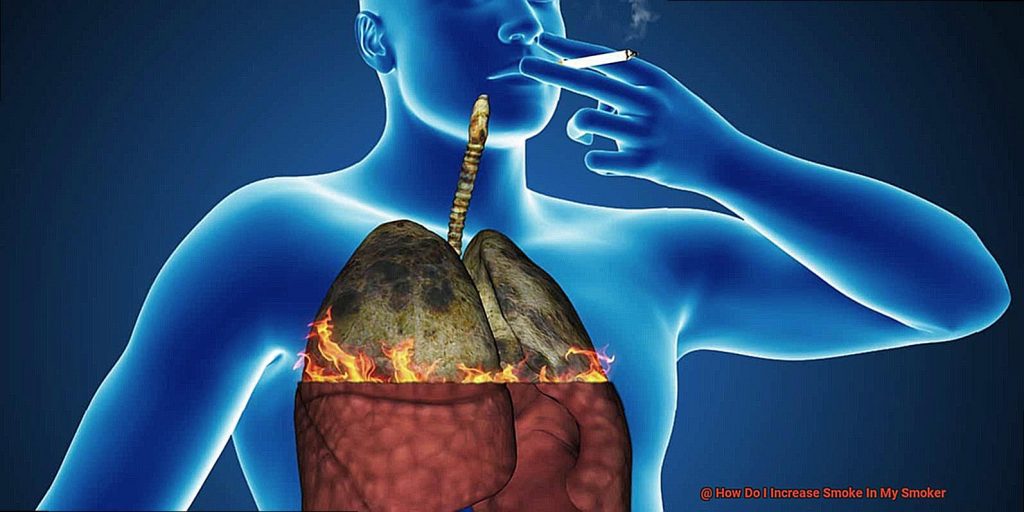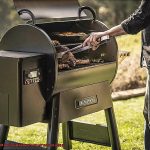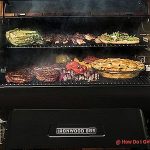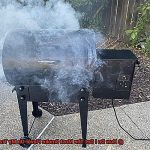Do you crave the mouth-watering flavor of smoked meat but struggle to get enough smoke in your smoker? Don’t worry, you’re not alone. It can be frustrating to spend hours preparing your meat only to end up with a bland taste. But fear not, there are plenty of ways to increase smoke in your smoker and take your smoking game to the next level.
In this article, we’ll provide a comprehensive guide on how to achieve that perfect smoky flavor. Whether you’re a seasoned pro or just starting out, these tips will help you achieve delicious results every time.
Firstly, we’ll discuss the importance of using the right wood chips and controlling moisture and temperature. We’ll also cover how opening and closing smoker vents can affect smoke production and explore smoking techniques like the minion method. And if you encounter any problems along the way, we’ve got you covered with troubleshooting tips.
So grab your favorite meat and let’s get started on your journey towards becoming a smoking master. With our guide, you’ll be able to create mouth-watering smoked dishes that will leave everyone asking for seconds.
Contents
What is Smoke and Why Do We Need It?
Smoke is more than just a byproduct of grilling or smoking meats – it’s an essential component that enhances flavor, aroma, and can even act as a natural preservative. So what exactly is smoke, and why do we need it?
Simply put, smoke is created when wood or charcoal is burned, producing gases and particles that infuse the food with a smoky flavor. This flavor comes from various compounds in the smoke, such as phenols and carbonyls, which contribute to the sweet and smoky taste, as well as the charred flavor that many of us love.
Aside from adding a unique taste to our food, smoke also has antimicrobial properties that help to inhibit the growth of bacteria and other microorganisms that can cause spoilage in meat. In fact, smoking was used as a preservation method long before refrigeration became widely available.
But how can we increase the presence of smoke in our smoker? One way is by using wood chips or chunks that produce more smoke. Certain types of wood like hickory, mesquite, and applewood are known for producing a lot of smoke and adding more flavor to meats. Soaking these chips or chunks in water or liquids like beer or wine can create even more smoke.

Adjusting airflow can also impact the amount of smoke produced. When there’s less oxygen in the smoker, the wood will smolder instead of burn, creating more smoke. Closing the vents on the smoker partially or fully can achieve this effect. However, it’s important to find the right balance since too much smoke can be overpowering and ruin the flavor of the meat.
Using a water pan in your smoker helps distribute smoke evenly throughout the smoker, resulting in consistent smoky flavor in your meats. The water evaporates as it heats up and creates steam, which helps to distribute the smoke throughout the smoker.
Lastly, smoking tubes or boxes can be used to increase smoke in your smoker. These devices are filled with wood chips and placed inside the smoker, producing smoke for a longer period compared to adding wood chips directly to the smoker.
Using Wood Chips or Chunks
Using wood chips or chunks in your smoker is a tried-and-true method to achieve just that. As an expert in this area, I’m thrilled to share some tips on how to use wood chips or chunks in your smoker like a pro.

First things first, choosing the right type of wood is crucial. Hardwoods like oak, hickory, and mesquite are excellent choices for smoking. Each imparts a unique flavor and aroma to your food, so don’t be afraid to experiment with different woods until you find the perfect match for your taste.
Once you’ve selected your wood, it’s time to soak it in water for at least 30 minutes before adding it to the smoker. This will prevent the chips from burning too quickly and create more smoke. You can soak them in a bowl or even a plastic bag – just ensure they’re fully submerged.
When it’s time to add the soaked wood chips or chunks to the smoker, you have a few options. If your smoker has a dedicated smoker box, add the chips there. If not, you can add them directly onto the hot coals if using a charcoal smoker. An electric smoker may require a smoke tube or box designed specifically for this purpose.
It’s crucial to monitor the amount of smoke being produced as too much smoke can result in bitter-tasting food. Start with a small amount of wood and adjust as needed. If the smoke starts to dwindle, add more soaked wood chips or chunks to keep it going.
However, it’s essential to keep in mind that using wood chips or chunks can create quite a bit of ash and debris. To prevent any build-up and maintain optimal performance, be sure to clean out your smoker regularly.
Adjusting Airflow
If you’re a fan of mouth-watering smoked meats, you know that getting the perfect amount of smoke is crucial. But how do you achieve that perfect balance of flavor and tenderness? The answer lies in adjusting airflow.
Your smoker’s venting system is the key to controlling the amount of air that flows in and out of your smoker. By adjusting the airflow, you can control the fire’s intensity and, consequently, the amount of smoke produced. To increase smoke production, you need to decrease the airflow by partially closing the vents. This process restricts the amount of oxygen that enters your smoker, slowing down the combustion rate and producing more smoke.
But be careful not to close the vents too much. This can cause your fire to go out or produce too little heat. It’s essential to find that sweet spot where you’re getting enough smoke without sacrificing heat. Be patient and monitor your smoker’s temperature gauge closely. Aim for a consistent temperature between 225-250°F. If the temperature starts to drop, open up the vents slightly. If it begins to rise too high, restrict the airflow again.
Remember, the more restricted the airflow, the more smoke your smoker will produce. But if you want to increase heat and reduce smoke production, you can open up the vents slightly to allow more oxygen into your smoker.
Here are some tips for adjusting airflow:
- Use high-quality wood chips to ensure a consistent burn.
- Soak your wood chips for at least 30 minutes before adding them to your smoker.
- Keep an eye on your smoker’s temperature gauge and adjust airflow as needed.
- Don’t be afraid to experiment with different levels of airflow to find what works best for you.
Using a Water Pan
Using a water pan is a game-changer that will take your smoking to the next level.
The water pan is an essential tool that regulates the temperature and humidity inside the smoker. It creates more smoke, which equals more flavor. The added moisture also keeps your meat from drying out during the smoking process, resulting in tender, delicious meats.
Using a water pan is simple. Fill it with water and place it in your smoker. Keep in mind that you should monitor the water level throughout the smoking process and refill it as needed. And if you’re feeling adventurous, try adding beer or apple juice to the water for an extra pop of flavor.
It’s important to note that not all smokers come with a built-in water pan. Fortunately, there are plenty of aftermarket options available for purchase. When choosing a water pan, make sure it’s compatible with your smoker and made from durable materials that can withstand high temperatures.
In summary, using a water pan is an effective way to increase smoke in your smoker and produce flavorful, juicy meats. To recap, here are some benefits of using a water pan:
- Regulates temperature and humidity
- Creates more smoke for enhanced flavor
- Keeps meat moist and tender
- Allows for added liquids like beer or apple juice
- Aftermarket options available for purchase
Using Smoking Tubes or Boxes
Look no further than smoking tubes or boxes. These accessories are a fantastic way to increase the smoke in your smoker and add a rich, flavorful taste to your meals.
Smoking tubes or boxes come in various sizes and shapes, made from materials such as stainless steel, cast iron, or aluminum. The most common type is the tube-shaped one, which is filled with wood chips or pellets and placed inside the smoker. These tubes allow you to control the amount of smoke produced, giving you the flexibility to create unique flavors for your food.
One of the most significant advantages of using smoking tubes or boxes is their versatility. By experimenting with different types of wood chips or pellets, you can create distinct flavors for your food. Whether you prefer a classic hickory or a sweeter applewood, smoking tubes or boxes have got you covered.
However, mastering this technique requires some practice and patience. You need to ensure that the smoking tube or box is positioned correctly inside the smoker, and that the wood chips or pellets are producing enough smoke without overheating the smoker.
To use smoking tubes or boxes, fill them with wood chips or pellets and light them up using a lighter or torch. Once they start producing smoke, place the smoking tube or box inside your smoker. The smoke produced will enhance the flavor of your food and give it a deliciously smoky taste.
Tips for Beginners to Increase Smoke in Smokers
Look no further. Here are five tips on how to increase smoke production in your smoker.
Use the right wood
Choosing the right type of wood is crucial to achieving the perfect amount of smoke. Hardwoods like hickory, oak, and mesquite produce stronger smoke flavors, while fruitwoods like apple and cherry produce milder smoke flavors. Experiment with different woods until you find the perfect balance for your taste buds.
Soak your wood
Soaking your wood chips or chunks in water for at least 30 minutes before adding them to the smoker can help increase smoke production. The wet wood takes longer to burn, resulting in more smoke production and a richer flavor profile.
Control the temperature
Maintaining a consistent temperature throughout the smoking process is essential for even smoke distribution. Lower temperatures generally result in more smoke production, so keep an eye on your smoker’s thermometer and adjust as needed.
Use a water pan
Adding a water pan to your smoker can help regulate humidity levels and prevent dryness in your meat. This moisture also helps create more smoke, resulting in a juicier and more flavorful final product.
Don’t peek
Tempting though it may be, opening your smoker too often releases heat and smoke, affecting the final product’s flavor and texture. Limit how often you open the smoker throughout the smoking process to maximize smoke production.
Bonus tip
Adjust airflow by partially or fully closing the vents to control oxygen flow, resulting in your desired level of smokiness.
The Benefits of Increasing Smoke in Smokers
Look no further than increasing the smoke in your smoker. Not only will it enhance the flavor of your food, but it can also provide several other benefits that you might not have considered before.
One of the most significant benefits of increasing smoke in smokers is that it acts as a natural preservative for your food. Say goodbye to harmful chemicals and additives – smoke inhibits the growth of bacteria and fungi, extending the life of your meat. This is especially useful for meats with a shorter shelf life, ensuring they stay fresh and safe to eat for longer.
- But the benefits don’t stop there – smoking your food can also reduce the amount of salt needed in your recipe. The smoky flavor adds depth to your dish without raising sodium levels, making it an excellent option for those with high blood pressure or other dietary restrictions. Plus, who doesn’t love a flavorful meal that’s also healthy?
- And let’s talk about texture – smoking your meat can take it from tough to tender. The slow and low cooking with smoke breaks down connective tissues in meats such as brisket or ribs, resulting in juicy meat that falls off the bone. And the cherry on top? The smoke creates a crispy outer layer, adding another layer of texture to your dish that will leave your guests wanting more.
Potential Challenges When Increasing Smoke in Smokers
If you’re looking to take your smoked meats to the next level, increasing smoke in your smoker can be a game-changer. However, there are some potential challenges you’ll need to navigate along the way.
One of the most significant challenges is maintaining consistent smoke throughout the cooking process. As the wood or charcoal burns down, smoke production can decrease, leading to unevenly cooked meat with varying levels of smokiness. To combat this, you’ll need to pay close attention to your fuel and make sure it doesn’t burn down too quickly.
Another challenge is controlling the temperature of your smoker while increasing smoke production. Too much smoke can cause excessively high temperatures, resulting in overcooked or burnt meat. Conversely, too little smoke can lead to undercooked meat with a lack of flavor. Finding that perfect balance takes practice and patience.
Additionally, the type and quantity of wood you use can significantly impact your smoke production. Some types of wood produce more smoke than others, so it’s essential to choose the right one for your desired level of smokiness. Too much wood, however, can lead to excessive smoke and a bitter taste in your meat.
Lastly, consider your smoker’s type and quality. Some smokers are designed to maintain consistent smoke production, while others require more frequent adjustments. Understanding how your equipment works will help you make the necessary adjustments to achieve the desired level of smoke.
L_TAnDSFX30″ >
Conclusion
To achieve that irresistible smoky flavor in your meat, increasing smoke production in your smoker is crucial. Not only does smoke add a unique taste to your food, but it also acts as a natural preservative and reduces the amount of salt needed in your recipe. So, how can you increase smoke production?
Choosing the right wood chips or chunks is key. Different types of wood produce different levels of smoke, so select one that complements the flavor of your meat. Moisture and temperature control are also essential factors to consider when increasing smoke production.
Adjusting airflow by partially closing smoker vents can affect smoke production, while using a water pan helps distribute smoke evenly throughout the smoker. Smoking tubes or boxes are another effective way to increase smoke production, but mastering this technique requires practice and patience.
However, there are potential challenges to navigate when increasing smoke production. Consistent smoke throughout the cooking process, controlling temperature while increasing smoke production, choosing the right type and quantity of wood chips or chunks, and understanding how your equipment works are some of these challenges.
But fear not. With our comprehensive guide on how to increase smoke in your smoker, you’ll be able to create mouth-watering smoked dishes that will leave everyone asking for seconds. So go ahead and experiment with different levels of airflow, high-quality wood chips soaked for at least 30 minutes before adding them to the smoker, and closely monitoring your smoker’s temperature gauge.






